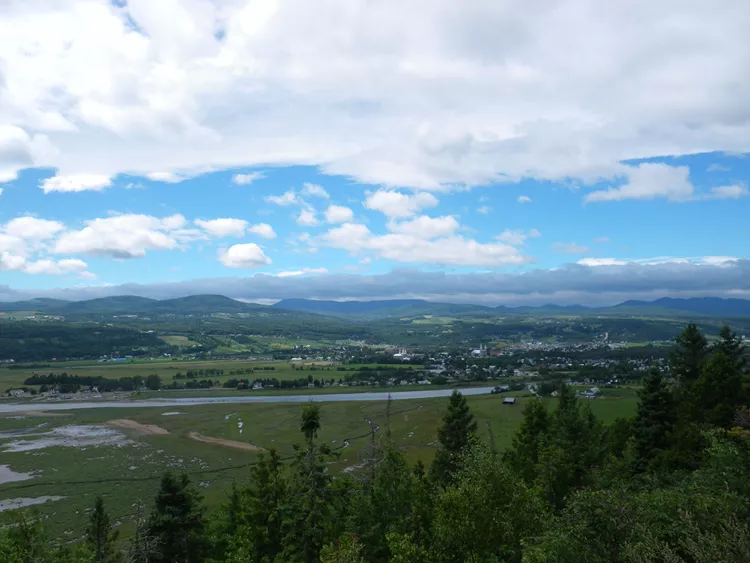Summary
Charlevoix is a stunning region in Quebec, Canada, renowned for its breathtaking topography, which includes rolling hills and majestic mountains lining the St. Lawrence River. The area’s unique landscape was shaped by the impact of a colossal meteorite millions of years ago, resulting in a crater nearly 60 kilometers wide.
This picturesque region draws many visitors due to its agritourism, farm-to-table culinary delights, vibrant arts scene, and beautiful driving routes. Additionally, the charming small towns scattered throughout Charlevoix provide an opportunity to immerse oneself in Quebec’s rich history through its captivating architecture.
1. Charlevoix Location

Covering an area of 6,000 square kilometers (2,317 square miles), Charlevoix begins just an hour east of Quebec City and extends along the north shore of the St. Lawrence River, concluding in the town of La Malbaie, close to Tadoussac.
A drive from Quebec City along the scenic St. Lawrence River, through the Charlevoix region to La Malbaie, offers spectacular views and the chance to visit charming riverfront villages.
2. Charlevoix Attractions

Charlevoix is a haven for outdoor enthusiasts, culinary lovers, and individuals intrigued by history and architecture. Key attractions in the region include the Manoir Richelieu, a breathtaking historic hotel overlooking the St. Lawrence River, and the renowned Le Massif de Charlevoix ski resort.
Additionally, the romantic Isle aux Coudres, just a 20-minute ferry ride from the mainland, enchants visitors with its historic buildings, stone windmills, and stunning coastal views. Biking around the island perimeter is a popular activity, offering a lovely experience.
Other attractions in Charlevoix include the regional Flavour Trail, featuring farms, breweries, and local gourmet cuisine, the picturesque St. Lawrence Route, the breathtaking Mountain Circuit, opportunities for whale watching, and the beautiful provincial parks throughout the region.
3. Getting to Charlevoix

For those planning a trip to Charlevoix, Quebec City serves as an ideal starting point. The drive from Quebec City to Charlevoix takes approximately an hour and a half along Hwy 138.
For air travelers, Charlevoix Airport, located just south of Malbaie, accommodates general aviation (but no commercial flights). The nearest international airport is in Quebec City, where rental cars and bus services are available.
Additionally, a ferry travels from the St. Lawrence South shore, linking Rivière-du-Loup and Saint-Siméon—a daily journey providing easy access to the region.
The scenic Le Massif de Charlevoix Train, running during the summer, offers a captivating railway experience connecting Quebec City with the coastal towns of Charlevoix.
4. Charlevoix – Fast Facts

- Distance from Quebec City: 93 kilometers (about an hour’s drive)
- Distance from NYC: 950 kilometers (approximately 10-hour drive)
- Population: Just over 13,000
- Economy: Based on agriculture, forestry, and tourism.
- Major towns: Baie-Saint-Paul, Malbaie, Saint-Siméon, Saint-Hilarion, Saint-Irenee, Les Eboulements, Isle-aux-Coudres.
5. St. Lawrence Route, Charlevoix

The St. Lawrence Route (Route du fleuve) traverses Charlevoix along the scenic Hwy 362 between Baie-Saint-Paul and Malbaie. It is widely regarded as one of Canada’s most picturesque driving routes.
Travelers seeking whale watching opportunities will find the St. Lawrence Route to be the most direct path to popular locations such as Baie-Sainte-Catherine and Tadoussac. Conversely, those interested in exploring local food producers might consider heading north on Hwy 138, which loops back down to Hwy 362 at Malbaie.
6. Manoir Richelieu Hotel in La Malbaie

At the eastern endpoint of the stunning St. Lawrence Route is La Malbaie, which boasts the magnificent Fairmont Manoir Richelieu. This historic hotel features a castle-like structure with luxurious interiors and beautifully manicured grounds overlooking the St. Lawrence River, making it a unique accommodation option.
Visitors can also enjoy amenities such as a casino, swimming pools, tennis courts, a 27-hole golf course, observatory, and more.
7. Whale Watching in Baie-Sainte-Catherine and Tadoussac

The area where Charlevoix meets the Saguenay Fjord is abundant in marine life and is one of Canada’s premier whale watching destinations. The prime time for whale watching occurs in spring when minke, beluga, and humpback whales migrate from the Gulf of St. Lawrence.
Baie-Sainte-Catherine is home to several whale watching operators offering cruises, Zodiac excursions, and kayak tours. Further options for whale watching are available just across the Saguenay River in Tadoussac. Accessing Tadoussac requires a free 10-minute ferry ride, which accommodates vehicles and operates 24/7.
While you can choose to stay in either Baie-Sainte-Catherine or Tadoussac, staying in Baie-Sainte-Catherine is convenient for whale watching since there is no need for ferry transport. However, it’s essential to note that lodging and dining options are more limited than in the more vibrant Tadoussac, which has a population of less than 1,000.





